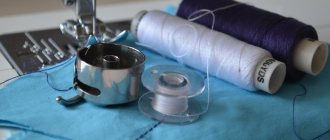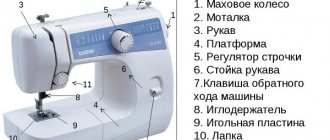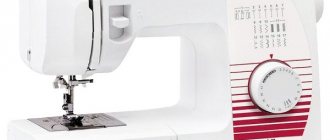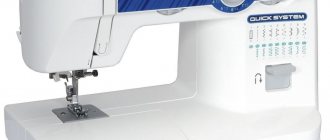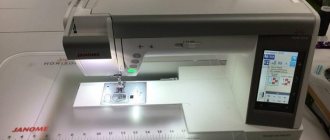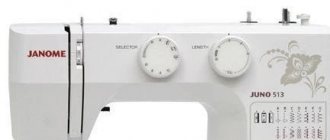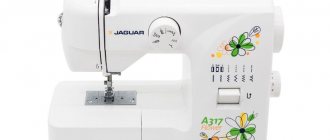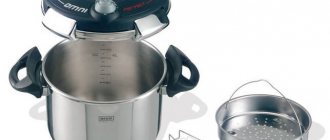Double needles for sewing machines are accessories with which a seamstress can perform many more tasks, do some work more accurately and better with less time.
For example, the element allows you to form a decorative seam on jeans or imitate flat seams on knitwear. It can be used on almost all sewing machines, regardless of the model.
How does a double needle work?
In essence, this product is a standard double needle. A common holder and bulb are used for two metal elements. The part is formed by the following elements:
- A bulb that looks like a thick bulb with a flat back. When the needle is installed in the clamp, the flat part should point straight back;
- Frame. It is the body based on polymer material that rigidly fixes the two needles, allows them to work synchronously, ensures the strength of the entire structure and the absence of deformation;
- Kernel;
- Long and short grooves;
- Ear;
- Point.
Rules for safe operation
The impact of the tip on a steel plate, at best, simply leads to bending of the part, and at worst, to a violation of integrity. At high speed, a fragment of the rod may well bounce off and cause serious injury. Therefore, before you start sewing:
- check the alignment of the needle and the slot in the plate;
- Be careful to ensure that the machine is set to straight stitch only and does not accidentally switch to zigzag, decorative stitching or embroidery.
Always remove pins and bobby pins before using the machine. Even if they do not come into contact with the rod and do not violate its integrity, they will loosen the rack.
Do not use blunt, much less bent, needles. The presence of such defects will inevitably lead to failure.
Subscribe to our Social networks
Types and models
Double needles are available in four main designs:
Universal. There are almost no restrictions on the material being processed; sewing with artificial or natural threads is acceptable. It is possible to form decorative seams, including zigzags, and work with low-density fabrics, be it tulle, silk or linen. Designation – “Universal”
Needles designed for stretch fabrics or fabrics formed by knitting. The peculiarity of such materials is their high degree of elasticity, they stretch, and a simple needle can get stuck in them. To eliminate this undesirable phenomenon, special needles are rounded at the end. Damage and ruptures are completely excluded. The product is marked “Stretch”
Working with high-density fabric is only possible with reinforced needles; simple ones can break, quickly become dull, or not provide sufficient efficiency. Examples of such fabrics are suit wool or jeans. Products are marked with the inscription “Jeans”
To work with threads that use metallized fibers, you must use appropriate needles marked “Metallic”
When classifying, you can also focus on the following parameters:
- Dimensions. This includes the diameter of the needle rods and the distance between them;
- The shade of the retainer, the body, which ensures the rigidity of the entire structure;
- Tip shape (they can be straight or rounded, depending on the structure and density of the material being processed);
- Dimensions of the needle eye.
A very important point is the dimensions. The main products are presented in 1.6, 2, 2.5, 3 and 4 millimeter models. Needles are used much less frequently, where the gap between the rods is 6 or 8 millimeters; they are aimed at performing specialized tasks and working with not the most common materials.
As in the situation with standard elements, the dimensions of double needles depend on the thickness of the rod. The thinnest ones are aimed at processing fabrics with elastic properties; they are number 75. To sew with threads with metallic inclusions, you need to use an 80-gauge needle.
The most universal are 90s, and for high-density fabrics, jeans, you need to use needles marked “100”.
The shades of the cases are a relative indicator; there are no specific standards here; each manufacturer uses its own color scheme. The main thing is to take into account what is written on the case, what numbers appear on it. The first number fixes the distance between the rods, the second – the dimensions.
Safety rules when performing work
As with all tools, safety rules must be followed with needles:
Needle storage option
- Place them in a special box so they don’t get lost;
- It is advisable to wrap them with thread;
- Broken needles should be thrown away;
- Know the sewing tool numbers;
- When the work is finished, count all the needles and check for losses;
- There is no need to insert them into foreign objects;
- During work, do not allow children to be near or touch the tools;
- After work, be sure to wash your hands, as the needles may contain metal particles that are harmful to health;
- Rusty sewing items may break halfway and get stuck in the machine;
- Do not use a rusty needle because it can leave stains on the products.
Triple stitching
It is advisable to use double needles if you are already an experienced tailor. They require high dexterity and skills from the master. Before starting work, it is advisable to watch several master classes in order to visually understand how to use needles in practice.
How to choose double needles?
When purchasing, be sure to pay attention to the maximum width of the hole in the plate of the sewing device. If there is a wide gap, it is impossible to use a double needle.
The second point is the width of the zigzag seam on the sewing machine. If it is limited, for example, to 7 millimeters, then this is the largest allowable distance between the needles. Some machines only allow the use of twin needles if certain conditions are met.
This is especially true for older models, where it is necessary to center the working element as accurately as possible. If the alignment is disturbed, there is a high probability of the needle hitting the plate, damage to the shuttle, and complex and expensive repairs.
Finishing stitch
What else can you use a twin sewing machine needle ? With a double needle you can make very beautiful finishing stitches , both with matching and contrasting threads. You can stitch with a straight double stitch, or you can do a zigzag stitch. Different stitch lengths and widths produce different patterns. They can be combined and alternated in colors.
Double needle video “Finishing stitches”
How to install double needle?
When installing, you must adhere to the following algorithm of actions:
- By rotating the flywheel you need to fix the needle holder at the top point;
- The device's foot lowers;
- If a regular needle is installed in the latch, it can be pulled out; to do this, just loosen the fastening screw;
- The double needle is turned with the plane part “away from you” and inserted into the needle holder until the edge of the flask begins to come into contact with the restrictive element;
- The fixing screw is tightened. To prevent the needle from falling out at this moment, you can carefully hold it with your left hand, while turning the screw with your right hand.
Features of the work process
First, it should be noted that not every machine is designed to use this model of tool. It is important that the device can perform a zigzag seam.
Some modern devices are initially designed for its installation, and already in their design have two racks for working threads.
When choosing such a tool, it is necessary to take into account the design aspects of the device itself, since the gap between the needles should not exceed the width of the hole for them. In order not to manually measure the distance, you can look at the instructions, which indicate the maximum possible zigzag width. It is this parameter that will determine the purchase.
Thus, we can highlight the main points without which it is impossible to use a double needle:
- The device provides for a zigzag seam;
- the gap should not exceed the maximum possible width of the zigzag stitch;
- filling type - front.
It is worthwhile to dwell on the features of threading. When performing this, it is important not to pull the upper working threads too tightly, since the only lower thread is secured simultaneously by the two upper ones. Incorrect tension can cause rupture.
How to thread a double needle?
The double needle process involves threading two spools of thread. The formation of an aesthetic, even seam is possible only if the same threads are wound on both spools.
The shade, however, can be different; in this regard, you can only be guided by the appearance of the line that needs to be formed.
A very important point is the identical “output” speed of the threads from both reels. Synchronicity is sometimes quite difficult to achieve; in some cases, you will have to rewind the threads onto bobbins of the same configuration, which will allow them to be installed on the same pin.
Threading the threads to create a double stitch is identical to threading a single stitch. If the machine is equipped with one thread guide, then the threads are passed through all thread guides, including the upper tensioner.
You only need to separate the two threads near the base. If there is a single thread guide installed below, then the left thread passes through it, while the right one is passed nearby and tucked into the eye of the right element.
This is a universal method, but it’s a good idea to look at the instructions for a specific model; it’s likely that the manufacturer gives certain recommendations.
Secrets of perfect stitching with a double needle
- To get a good stitch with a twin needle, try lowering it a couple of millimeters.
- Often the reason for missing stitches is that the needle does not fit the material: for example, for very elastic fabrics it is worth using super stretch needles rather than universal ones.
- Don't stitch too fast: for beginners, speed greatly affects the quality of the stitch.
- To attach the bartack, press reverse and sew two or three stitches in the opposite direction, and then the words towards you.
- Once you've finished stitching, cut off the excess material close to it and iron it.
If you plan to work closely with knitwear, for example, sewing sweatshirts or dresses for sale, it is better to invest in a sewing machine; with it, the stitches will be neater and, most importantly, much more reliable. But don’t forget about the double needle, because with it you can make not only a regular flat seam, but also many beautiful decorative stitches!
Be sure to watch the detailed video we prepared!
You can always get practice using a sewing machine during lessons at our sewing school in St. Petersburg and Moscow.
Reliefs with cord
To do this, you need a foot designed for embossed pinching or sewing in beads. In the area where the cord will be located, you need to draw a line with chalk or a felt-tip pen. The cord needs to be pinned from the inside out. Then the fabric is placed under the foot so that the cord is located between the needles. After this you can start sewing. The result is beautiful reliefs that can decorate any product.
Relief protection
Decorative patterns are made using this device. To do this, you will need a special foot for creating tucks. It differs from the usual one in that it is equipped with grooves on the sole, which lift the material when performing work.
When creating this stitch, the pattern is influenced by many reliefs on the foot itself, as well as their depth. The larger it is, the more embossed the fabric will be. The thread tension regulator is set to maximum. Material consumption during pattern creation increases.
